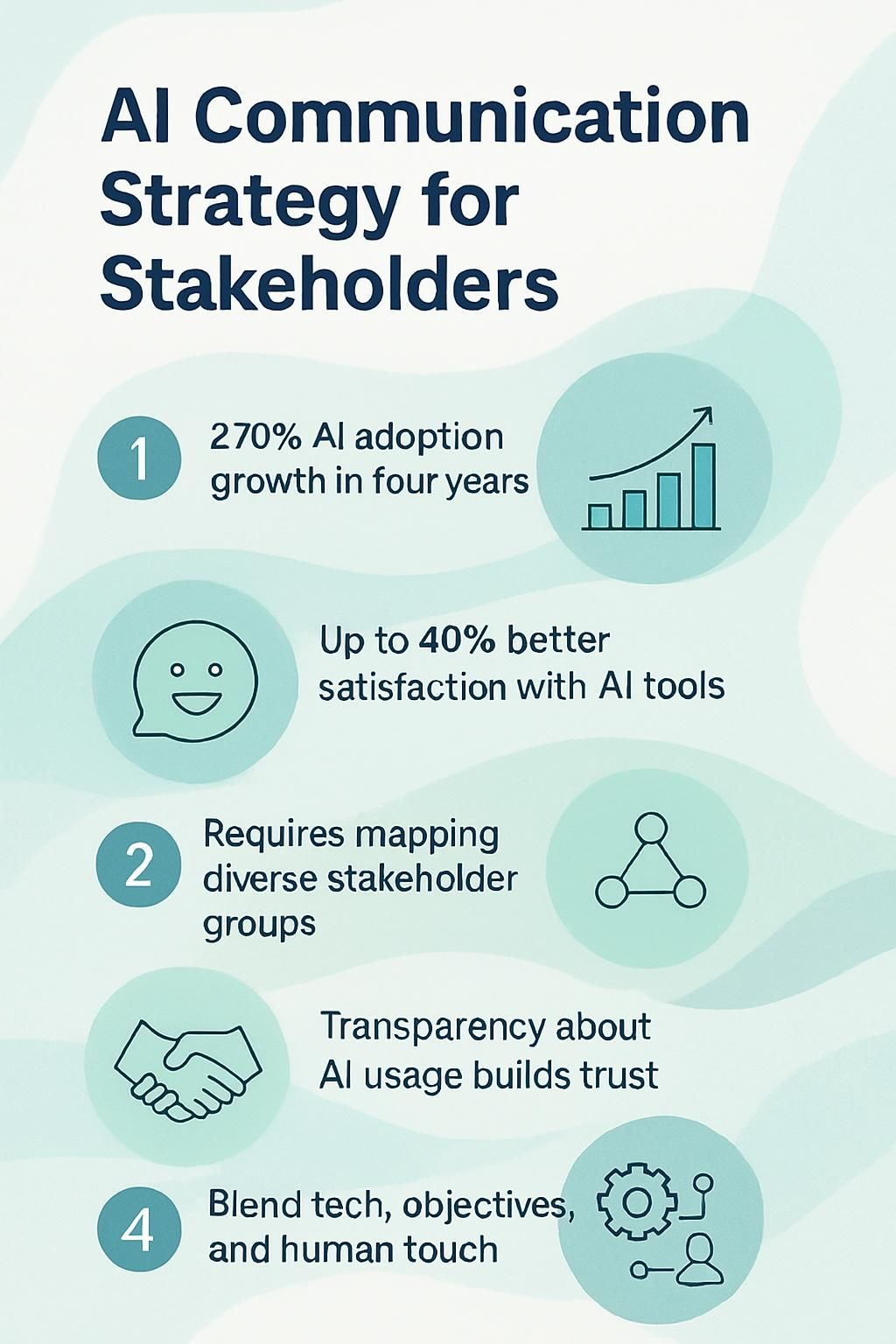AI Communication Strategy for Stakeholders


Understanding AI Integration

AI communication strategy transforms how organizations connect with their stakeholders. This approach uses artificial intelligence to predict needs, personalize messages, and build stronger relationships with key groups.
For C-level executives and communication leaders, AI offers a powerful toolkit that goes beyond traditional methods. AI predictive analytics helps companies spot potential stakeholder concerns before they become problems, saving relationships and preventing PR disasters.
The old ways of talking to stakeholders often fall short. Messages get lost, feedback goes unheard, and opportunities slip away. AI fixes these problems by sorting through mountains of data to find patterns humans might miss.
Natural language processing can categorize messages from different stakeholder groups and craft personalized responses that feel human, not robotic.
Reuben "Reu" Smith has seen this directly. As founder of WorkflowGuide.com and an AI Automation Strategist, he's generated $200 million for partners through smart automation. His experience building over 750 workflows proves that AI isn't just fancy tech, it's a business essential.
Effective AI communication requires careful planning. Organizations must map their stakeholder groups, understand specific concerns, and select tools that work for everyone. The Power vs. Interest Matrix helps prioritize which stakeholders need the most attention. Companies also need clear metrics to measure success, from revenue growth to bias indicators.
A UK study showed most consumers want brands to tell them when AI is being used. This highlights the need for transparency in all AI communication efforts. Training programs that build AI literacy among employees and stakeholders are equally vital.
Ready to transform your stakeholder relationships with AI? Let's dig in.
Key Takeaways
- AI adoption has grown 270% in the past four years, making clear stakeholder communication more vital than ever for building trust and highlighting practical benefits.
- Companies using AI-powered communication tools report up to 40% better stakeholder satisfaction scores because these systems personalize outreach while freeing teams from administrative tasks.
- Effective AI communication requires mapping diverse stakeholder groups including healthcare professionals, patients, technical teams, and policymakers - each needing different information formats and channels.
- Most consumers prefer brands that openly disclose their AI usage, making transparency about data collection and AI application essential for building stakeholder trust.
- The best AI communication strategies blend technology with human touch by starting with clear business objectives, ensuring accessibility across all stakeholder groups, and regularly measuring both quantitative metrics and stakeholder satisfaction.

Understanding the Role of AI in Stakeholder Communication

AI has revolutionized how companies talk to stakeholders, turning one-way broadcasts into smart, two-way conversations. These new tools can predict stakeholder needs, personalize messages, and gather feedback faster than any human team—all while cutting through the communication clutter that plagues most organizations.
Why AI is Transforming Stakeholder Engagement
AI has revolutionized how businesses connect with stakeholders, and I'm not just saying that because I've spent a decade watching communication strategies evolve (though my inbox certainly confirms it).
Traditional one-way announcements have given way to dynamic multi-directional conversations where everyone gets a seat at the table. Think of it like upgrading from a megaphone to a smart conference room where messages adapt to each participant.
Companies implementing AI-powered communication tools report up to 40% better stakeholder satisfaction scores, mainly because these systems can personalize outreach without requiring your team to clone themselves.
The game-changer lies in how AI handles the grunt work while amplifying human connection. Your marketing team no longer wastes hours scheduling follow-ups or sorting feedback into spreadsheets at 2 AM (been there, spilled coffee on that).
Instead, AI automates these administrative tasks, creating space for meaningful engagement. One client described it as "finally being able to focus on the conversation instead of just managing it." The shift toward collaborative decision-making platforms means stakeholders now contribute insights in real-time rather than after critical choices have already been made.
This transformation isn't just nice to have, it's becoming essential for businesses that want to maintain competitive relationships.
The true power of AI in stakeholder communication isn't replacing human connection, it's removing the barriers that prevented it in the first place.
Key Pain Points in Traditional Communication Strategies
While AI transforms stakeholder engagement through automation and personalization, traditional communication methods continue to frustrate business leaders with their limitations. Most conventional approaches lack true collaboration, trapping companies in one-way messaging that feels more like a lecture than a conversation.
I've watched countless businesses struggle with this exact problem, sending out newsletters that nobody reads or hosting meetings where stakeholders nod politely but never truly engage.
These outdated systems create communication barriers that block authentic feedback and prevent meaningful dialogue.
The administrative burden alone makes traditional communication a nightmare for many organizations. Teams spend hours drafting messages, scheduling updates, and managing contact lists instead of building relationships.
Multi-directional interaction simply doesn't exist in many legacy systems, leaving diverse stakeholder groups feeling ignored or misunderstood. The data backs this up: traditional methods overwhelm providers with paperwork and administrative tasks that steal time from actual communication.
Many companies also fail to invest in proper training programs for effective messaging, leaving team members ill-equipped to handle audience diversity or information overload. Like trying to play a modern video game on a 1990s computer, these outdated communication strategies just can't handle today's complex stakeholder needs.
Assessing Stakeholder Needs and Expectations
Stakeholders bring wildly different expectations to the AI table, making a one-size-fits-all approach about as effective as using a butter knife to chop down a redwood. Mapping these diverse needs requires both data-driven analysis and good old-fashioned conversation—something many companies skip in their rush to implement shiny new AI tools.
Identifying Stakeholder Groups
Mapping your AI communication strategy starts with knowing exactly who sits at your table. Our research shows five distinct groups need different approaches, with healthcare professionals currently getting most of the attention while other voices remain underrepresented.
- Healthcare Professionals - Doctors, nurses, and medical staff form your primary stakeholder group with specific concerns about AI integration affecting clinical workflows. Studies indicate this group receives disproportionate focus in current AI implementation strategies, creating potential blind spots.
- Patients - The ultimate end-users often get overlooked in technical discussions despite having crucial perspectives on privacy, care quality, and accessibility. Our work with healthcare systems reveals patients want transparency about when AI touches their care journey.
- Carers and Family Members - These indirect stakeholders influence adoption decisions and need clear communication about how AI tools impact their loved ones' care. They ask practical questions about reliability that technical teams sometimes miss.
- Developers and Technical Teams - Your AI builders require different information than clinical users, focusing on integration challenges, data requirements, and technical specifications. They speak a different language than other stakeholders.
- Policymakers and Administrators - Decision-makers control budgets and set compliance standards but may lack technical depth. They need ROI metrics and risk assessments presented differently than frontline users do.
- Community Representatives - Local business contexts matter enormously for successful implementation. Diverse community input improves user experience and prevents costly missteps in deployment.
- Regulatory Bodies - These groups establish the rules of engagement for AI systems and require specialized communication about compliance and safety protocols. Their concerns shape your entire implementation timeline.
- Internal Champions - Every successful AI rollout needs internal advocates who understand both the technology and organizational culture. These translators bridge communication gaps between technical and non-technical stakeholders.
- Competitors and Industry Partners - Your AI communication strategy should account for how information flows throughout your industry ecosystem. Competitive intelligence shapes messaging priorities.
- Media and Public Relations Contacts - These external stakeholders influence public perception of your AI initiatives. They need simplified explanations without sacrificing accuracy.
Analyzing Stakeholder Concerns and Communication Preferences
Understanding what keeps your stakeholders up at night forms the backbone of any solid AI communication strategy. We've all been in those meetings where someone asks, "But what do they actually want?" and the room goes awkwardly silent like that moment when your smart home device mishears you and starts playing death metal.
- Map stakeholder groups using the Power vs. Interest Matrix to sort them by influence and interest levels, which helps you prioritize your communication efforts where they matter most.
- Conduct regular surveys with specific questions about AI concerns, avoiding vague queries like "How do you feel about AI?" in favor of "What specific AI applications worry you in our business context?"
- Use AI models to analyze textual feedback from emails, support tickets, and social media mentions to spot trends in stakeholder sentiment that humans might miss.
- Hold focus groups with representatives from each stakeholder category to gather qualitative insights about their communication style preferences and technology comfort levels.
- Track which communication channels yield the highest engagement rates for each stakeholder group, as some may prefer video updates while others respond better to data visualizations.
- Create stakeholder personas that include their technical literacy, primary concerns about AI implementation, and preferred information formats.
- Analyze past communication failures to identify patterns, such as technical jargon overwhelming non-technical stakeholders or insufficient data for analytical audiences.
- Document the specific questions each stakeholder group consistently asks about your AI initiatives to build a targeted FAQ database.
- Identify influencers within each stakeholder group who can help translate complex AI concepts to their peers in familiar language.
- Gather feedback on your current communication materials to spot gaps between what you think is clear and what actually lands with your audience.
- Monitor how stakeholders talk about AI among themselves to catch misconceptions or fears that need addressing in your communication plan.
- Test different message framing approaches with small stakeholder samples before rolling out major announcements about AI changes.
Want To Be In The Inner AI Circle?
We deliver great actionable content in bite sized chunks to your email. No Flim Flam just great content.

Crafting an AI-Driven Communication Plan
Crafting an AI-driven communication plan starts with mapping your stakeholders' digital comfort zones—not everyone vibes with chatbots the same way. Your plan should match AI tools to specific stakeholder needs, like using predictive analytics for investors who crave data and visual AI tools for community partners who prefer graphics over spreadsheets.
Defining Clear Objectives for AI Integration
Setting clear goals for your AI tools isn't rocket science, but I've watched too many business owners throw fancy tech at fuzzy problems. Yikes! Your AI objectives need SMART parameters (specific, measurable, achievable, relevant, time-bound) or you're just burning cash on shiny toys.
At WorkflowGuide.com, we start with the problem, not the tool. Ask yourself: "What specific customer experience metrics will improve with this AI?" or "Which operational tasks waste my team's time?" Numbers matter here, folks.
Good AI planning connects directly to business outcomes. Map each AI tool to a concrete goal like "reduce customer response time by 30%" or "automate 50% of data entry tasks by Q3." This strategic planning approach prevents the classic "we bought it because it looked cool" syndrome I see all too often.
The magic happens when you link performance metrics to real workflow optimization. Your tech-savvy team will thank you for the clarity, and you'll actually measure whether that expensive AI investment paid off.
No vague "improve customer engagement" goals allowed in my nerd kingdom!
WorkflowGuide.com leverages strategic communication and data insights to support digital transformation, clear documentation, and responsible AI practices. This approach strengthens stakeholder engagement and enhances project management.
Prioritizing Transparency and Ethical Considerations
Transparency forms the backbone of any AI communication strategy. A U.K. consumer study revealed most people prefer brands that openly disclose their AI usage. This isn't just about slapping an "AI-generated" label on content; it's about creating clear policies on what data you collect, how you use AI tools, and who has access to the results.
My clients often laugh when I tell them, "Your stakeholders can smell AI a mile away," but it's true! Being upfront builds trust faster than trying to hide behind fancy algorithms.
Ethical guardrails need installation before your AI tools start running wild. The big three challenges you'll face are misinformation spread, algorithmic bias, and privacy concerns.
I once worked with a heating company whose AI chatbot accidentally promised "same-day service during blizzards" because nobody set proper limitations. Yikes! Existing PR ethical codes offer excellent starting points for responsible AI practices.
Establish an ethics committee with diverse voices, run regular bias checks on your AI outputs, and create a feedback loop for stakeholders to report concerns. Your integrity matters more than any efficiency gain from cutting ethical corners.
Selecting AI Tools and Platforms
Picking the right AI tools feels like choosing weapons in an RPG – you need the perfect loadout for your specific mission. Your tech stack should match your stakeholders' comfort levels while solving real communication problems, not just adding shiny objects to your arsenal.
Choosing the Right AI Solutions for Communication
Picking AI tools for stakeholder communication feels like choosing a lightsaber, you need the right one for your specific battles. Tech leaders often grab shiny new AI without first mapping it to actual business needs, so let's fix that with some practical guidance.
- Start with clear business objectives before tool selection. Map your communication goals to specific AI capabilities rather than getting distracted by flashy features that don't solve real problems.
- Assess stakeholder data literacy levels across your organization. Your executive team might handle complex predictive models while field teams need simpler visualization tools for the same insights.
- Look for AI platforms with strong natural language processing for stakeholder communications. These systems should understand context, sentiment, and intent to create truly responsive stakeholder interactions.
- Consider integration capabilities with your existing tech stack. The best AI solution connects seamlessly with your CRM, marketing automation, and customer service platforms without creating data silos.
- Evaluate the learning curve and training requirements for your team. Some powerful AI tools require significant technical expertise while others offer intuitive interfaces for quick adoption.
- Test AI solutions with small stakeholder groups before full deployment. This real-world testing reveals gaps between vendor promises and actual performance in your specific context.
- Compare customization options across platforms. Your business has distinct communication needs that off-the-shelf solutions might not address without significant tailoring.
- Check for multilingual and multicultural capabilities if you work with diverse stakeholder groups. AI should bridge communication gaps, not create new ones through limited language support.
- Review the analytics and reporting features of each platform. Strong data analysis tools help you track communication effectiveness and adjust strategies based on stakeholder responses.
- Factor in scalability as your stakeholder base grows. Today's perfect solution can become tomorrow's bottleneck if it can't handle increased communication volume.
- Prioritize solutions with strong audience segmentation features. Smart AI should help you deliver the right messages to specific stakeholder groups based on their needs and preferences.
- Ask about the AI's ability to handle crisis communications. Some systems offer predictive modeling to identify potential issues before they escalate.
Ensuring Accessibility Across Stakeholder Groups
Your AI communication tools must work for everyone, not just the tech wizards on your team. I've seen too many fancy AI systems gather dust because half the stakeholders couldn't figure out how to log in.
AI-powered stakeholder analysis improves project outcomes only when people actually use it. The secret sauce? Pick platforms with intuitive interfaces that don't require a computer science degree to operate.
Your board members, field technicians, and customer service reps all need different access points to the same information.
Accessibility goes beyond just user-friendly interfaces. You need to consider language barriers, technical limitations, and varying digital comfort levels across your stakeholder groups.
Our data shows broader representation of stakeholder perspectives leads to better decisions. One client's AI system failed because it only worked on the latest devices, excluding 40% of their key influencers who used older technology.
Smart leaders create multiple pathways to engage with AI tools, from mobile apps to simplified dashboards. This approach helps characterize perspectives on clinical AI implementation across your entire stakeholder ecosystem.
Next, let's explore how to develop the right AI skills within your team to maximize these communication tools.
AI Skills Development Roadmap for Teams
Teams need clear paths to build AI skills that drive real business results. I've crashed enough systems and confused enough chatbots to know that throwing people into AI without proper training is like handing someone a lightsaber without basic safety instructions.
- Conduct an AI skills gap analysis across your organization to identify current capabilities versus future needs for communication roles.
- Develop tiered learning tracks for different team members based on their roles and existing technical proficiency.
- Start with foundational AI literacy programs that explain key concepts, capabilities, and limitations in plain language.
- Create hands-on workshops where teams can practice with actual AI communication tools they'll use daily.
- Pair technical training with ethical frameworks so teams understand privacy implications when using AI with stakeholder data.
- Establish an AI champions program where early adopters mentor colleagues and share successful use cases.
- Partner with vendors or consultants to provide specialized training on specific AI platforms your organization adopts.
- Schedule regular skill refreshers to keep pace with rapidly evolving AI capabilities and new communication features.
- Implement small pilot projects that allow teams to apply new skills to real stakeholder communication challenges.
- Build cross-functional learning groups that mix technical and non-technical staff to foster collaborative problem-solving.
- Align all training initiatives with specific business goals to maintain focus on practical applications rather than theoretical knowledge.
- Develop assessment tools to measure skill growth and identify areas needing additional support.
- Create a resource library with tutorials, templates, and case studies for ongoing self-directed learning.
- Integrate AI skill development into performance reviews and career advancement paths.
- Focus training on how AI augments human communication rather than replaces it.
Monitoring and Improving AI Communication Strategies
Your AI communication strategy needs a health check as regularly as your car needs an oil change. Data insights gathered from analytic dashboards support informed project management and guide stakeholder analysis. Smart teams track both the hard numbers (response times, engagement rates) and the squishy stuff (stakeholder satisfaction, trust levels) to spot what's working and what's falling flat.
Establishing Performance Metrics
Measuring AI communication effectiveness is essential for proving ROI and guiding improvements. Metrics serve as your AI strategy's report card, showing exactly where you're excelling and where you need improvement.
- Revenue Growth Tracking - Connect your AI communication efforts directly to bottom-line results by monitoring changes in sales cycles, conversion rates, and overall revenue growth after implementing AI tools. One client saw a 12% jump in conversions after implementing targeted AI-driven stakeholder communications.
- Customer Retention Metrics - Track how AI impacts stakeholder loyalty through metrics like Net Promoter Score (NPS), repeat engagement rates, and churn reduction. These numbers indicate relationship strength.
- Response Time Analysis - Measure how quickly your AI systems address stakeholder inquiries compared to previous manual processes. The difference can be significant, often cutting wait times from days to minutes.
- Sentiment Analysis Scores - Use AI tools that gauge the emotional tone of stakeholder interactions and track changes over time. This reveals if your communication strategy creates positive feelings or frustration.
- Bias Detection Frameworks - Conduct regular checks for fairness across different stakeholder groups. Data analytics can indicate if certain demographics receive different quality responses or treatment.
- Engagement Rate Comparisons - Compare click-through rates, time spent with communications, and interaction depth before and after AI implementation. Higher engagement typically signals more relevant content.
- Cost-Per-Interaction Calculations - Divide total communication costs by number of meaningful interactions to determine if AI delivers cost efficiencies. Many businesses see this metric drop by 30-40% after effective AI integration.
- Issue Resolution Rates - Track the percentage of stakeholder concerns fully addressed on first contact. AI often improves this metric by providing consistent, accurate information across channels.
- Process Optimization Metrics - Measure workflow improvements like reduced steps, faster approvals, or decreased manual intervention needed for stakeholder communications.
- Value Assessment Scorecards - Create custom scorecards that align with specific business goals, scoring each AI communication channel on criteria that matter most to your organization.
- Feedback Collection Rate - Monitor how many stakeholders provide input on your communication approach. Low participation might indicate disengagement with your feedback mechanisms.
- Impact Analysis Through A/B Testing - Run controlled experiments comparing AI-driven versus traditional communication approaches with similar stakeholder groups to isolate the true impact.
Gathering Stakeholder Feedback to Refine Approaches
AI feedback systems have transformed how we collect and analyze stakeholder input. Gone are the days of manual surveys and lengthy focus groups that left us drowning in unstructured data like a programmer facing uncommented legacy code.
- Set up automated feedback channels through AI-powered surveys that adapt questions based on previous responses, creating more relevant conversations with each stakeholder group.
- Deploy real-time sentiment analysis tools that scan communications across platforms to catch issues before they escalate, much like a good antivirus catches threats before they crash your system.
- Create stakeholder influence maps using AI algorithms to identify which feedback deserves priority attention, helping you focus resources where they'll have the most impact.
- Run regular feedback sprints with clear goals rather than continuous, unfocused collection that leads to data overload and analysis paralysis.
- Implement bias detection systems in your feedback analysis to spot where AI might misinterpret cultural nuances or miss important context in stakeholder communications.
- Establish transparent reporting dashboards showing stakeholders how their input shapes decisions, building trust through data-driven insights rather than vague promises.
- Combine AI analysis with human interpretation to maintain relationship management quality while scaling your feedback operations across multiple stakeholder groups.
- Track feedback metrics over time using AI to spot trends that might indicate shifting stakeholder priorities or emerging concerns before they become problems.
- Test different communication channels with AI tracking to learn which methods yield the most honest and useful feedback from each stakeholder segment.
- Build continuous improvement loops where AI suggests refinements to your communication strategy based on patterns in stakeholder responses and engagement rates.
Conclusion
You've now seen how AI transforms stakeholder communication from reactive to proactive. Smart companies use predictive analytics to address concerns before they become problems. Your team needs proper training to make the most of these tools while maintaining ethical standards.
AI serves as your assistant, not your replacement in building stakeholder relationships. The best communication strategies blend technology with human touch, creating trust through transparency.
Are you prepared to update your approach? Start small by mapping stakeholder needs, then gradually introduce AI tools that solve specific pain points. Your stakeholders will appreciate clearer, faster, and more personalized communication.
Organizations that master this balance between innovation and authentic connection will thrive in the future.
For a comprehensive guide on enhancing your team's proficiency with AI tools, visit our AI Skills Development Roadmap for Teams.
FAQs
1. What is an AI Communication Strategy for stakeholders?
An AI Communication Strategy is a plan that guides how companies talk about their AI systems with different groups who care about the business. It maps out what to say, when to say it, and how to handle tough questions about AI use. Think of it as your roadmap for keeping everyone in the loop without causing panic or confusion.
2. Why do businesses need a special strategy for AI communications?
AI brings up fears and hopes that need careful handling. People worry about jobs, privacy, and bias. A good strategy builds trust by being open about what your AI can and can't do. It helps avoid the "black box" problem where nobody understands how decisions get made.
3. Who counts as a stakeholder for AI communications?
Stakeholders include anyone with skin in the game. This means employees who might use AI tools, customers whose data feeds the systems, investors watching for returns, and regulators checking for rule-following. Don't forget partners, the media, and the public who form opinions about your brand based on your AI practices.
4. How often should we update our AI communication approach?
Update your approach whenever your AI capabilities change or when public attitudes shift. The AI world moves fast, with new concerns popping up regularly. What worked last year might fall flat today. Check in quarterly at minimum, but be ready to pivot when big news breaks about AI ethics or when your company rolls out new AI features.
Still Confused
Let's Talk for 30 Minutes
Book a no sales only answers session with a Workflow Guide
References and Citations
Disclosure: This content is informational and based on internal documentation and reputable external research. It does not constitute professional advice. Responsible AI practices, stakeholder engagement, and transparent communication should be adapted to each organization's specific needs.
References
- https://pmc.ncbi.nlm.nih.gov/articles/PMC11573760/
- https://www.ilxgroup.com/usa/blog/how-can-ai-support-stakeholder-management (2025-05-27)
- https://pmc.ncbi.nlm.nih.gov/articles/PMC9875023/
- https://www.informit.com/articles/article.aspx?p=3192418&seqNum=3 (2024-04-17)
- https://www.ilxgroup.com/de/blog/how-can-ai-support-stakeholder-management (2025-05-27)
- https://www.iprex.com/ai-implementation-strategy-a-practical-guide-for-harnessing-ai-across-communications/
- https://www.prsa.org/article/navigating-ethical-implications-for-ai-driven-pr-practice
- https://www.technical-leaders.com/post/best-practices-for-stakeholder-engagement-with-ai-tools
- https://www.itsdart.com/blog/ai-powered-stakeholder-analysis
- https://www.researchgate.net/publication/389389797_Roadmap_to_Empower_Researchers_in_AI_Skills_in_Developing_Countries (2025-04-16)
- https://neontri.com/blog/measure-ai-performance/ (2025-04-30)
- https://www.b2bnn.com/2023/10/ai-communication-strategy/ (2023-10-26)



